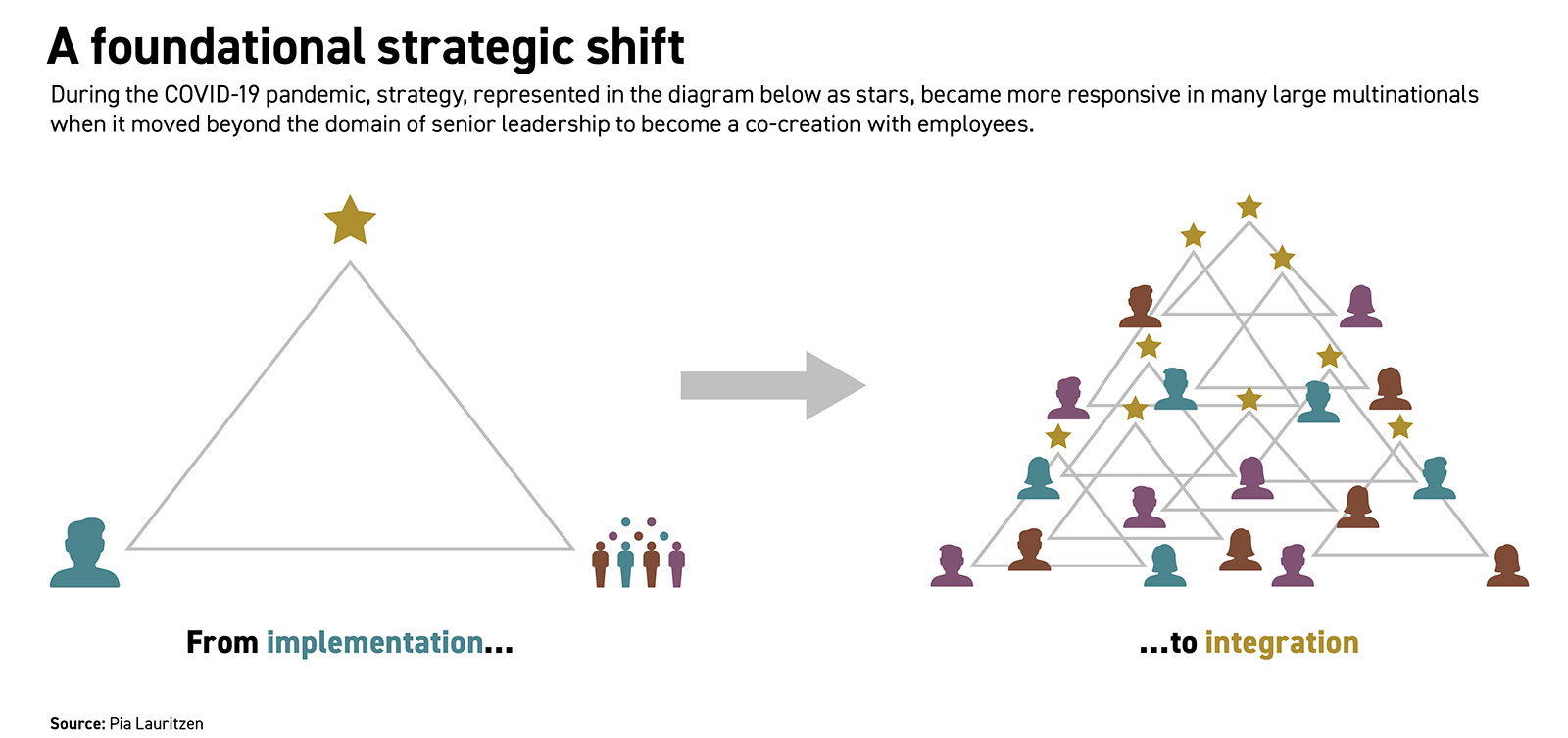How to make big, old companies act fast
Five shifts have changed the way successful legacy multinationals do strategy.
Like other CEOs, Cees ’t Hart instinctively knew that the COVID-19 pandemic required him to manage Denmark’s Carlsberg differently. “The crisis has raised a lot of questions,” he told Danish business newspaper Børsen in May 2020. Rather than centralize Carlsberg’s response to those questions, he saw opportunities to explore a more autonomous global management structure and find a new way to develop and implement strategy.
Decisions had to be made on the ground, quickly, so regional leaders were given the power to act fast, a fact noted in Carlsberg’s 2020 annual report. Financial results, despite the drop-off caused by the pandemic last year, are now back to 2019 levels.
Carlsberg is what I define as a legacy company. These are businesses that are more than 50 years old, have well-established brands and market positions, employ more than 5,000 people, and are spread around the world. Their legacy consists of decades of experience and accumulated insight into the markets in which they operate. They have gone through numerous transformations and adapted to multiple reorganizations and changing management principles.
How did such organizations do strategy differently as a result of the pandemic? They flipped their hierarchies and learned to listen in a new way. Prior to the spread of COVID, senior executives in large legacy companies would often say that their organizations were far too complex for everyone to be involved in strategic discussions and decisions. That has changed. The nature of the crisis has shown that what counts is alignment on the same strategic agenda coupled with the autonomy to act. Working with three European multinationals during the pandemic, I saw five significant attitude shifts that showed how deeply the crisis has affected the way these types of companies do strategy.
Shift in mindset: From implementation to integration
Many large companies have long regarded strategy development and strategy execution as two separate things. Before the pandemic, top management was generally seen as responsible for developing strategies, while middle managers and employees were responsible for executing them. When something didn’t go as planned, senior managers talked about the execution gap and failed implementation, but they never connected the organization’s difficulties implementing strategies with the way they had been developed.
With the advent of the pandemic, executives realized they had to change tack. Instead of well-designed strategies plotted out in sealed boardrooms, they needed strategies dynamic enough to receive market feedback and flexible enough to evolve. That called for a much shorter distance between decision and action, and vice versa: changes in the market had to be captured immediately in order to make relevant strategic decisions.
Instead of well-designed strategies plotted out in sealed boardrooms, executives needed strategies dynamic enough to receive market feedback and flexible enough to evolve.
For example, before the pandemic, one family entertainment company was exceptionally good at building a consistent brand that is known by people from all walks of life. It also invested heavily in building organizational agility and becoming a digital consumer company. But like other companies, it made a clear distinction between strategy development and strategy implementation, and it didn’t have a systematic and structured approach to aligning people on the same strategic agenda.
During the pandemic, the team that was responsible for building organizational agility in this company went through a fundamental shift in mindset. Instead of asking how to implement strategic decisions made by senior management, they asked how to integrate strategy into every employee’s everyday actions (see diagram). They found that employees were overwhelmed with directives that stalled action, so they pared down new initiatives. This led to a significant change in how decisions were made and cut the time to action because it brought clearer focus.
This fundamental shift in mindset lays the groundwork for the other four shifts.
Shift in focus: From communication to conversation
Isolated in their home offices during the pandemic, most executives turned to one of the oldest and most well-worn assumptions within management: that organizations need as much communication from top management as possible, especially in times of crisis.
But the companies that made the shift in mindset from implementation to integration didn’t respond to the lockdown with more online town halls, ask-me-anything sessions, and written updates on management decisions. They focused on engaging employees in peer-to-peer conversations about strategic initiatives. They understood that the more complex the company’s situation, the more people must be involved in identifying and solving the most important strategic problems.
For example, one large global water technology company realized it would need to upskill its people to adapt to the situation. But instead of designing a detailed learning program and cascading it into the organization, the learning and development team invited key stakeholders across the organization to help shape the building blocks of the new learning framework. The chief human resources officer wanted people to practice learning so that the company would succeed in its strategic priority of becoming a world-class learning organization. The L&D team supported that ambition by providing conversation spaces where people from different parts of the organization could engage in peer-to-peer conversations about the topics they considered most important in helping the company succeed. The shift in focus from one-to-many communication to peer-to-peer conversations mobilized people around the new learning initiative, and helped senior management learn from employees where to focus their efforts for the biggest impact.
Shift in tech: From answer-data to question-data
The desire to provide conversation spaces at a time when a lot of people are working from home and unable to travel has forced companies to look for new kinds of technology. Microsoft Teams, Zoom, and other such platforms kept people collaborating and communicating by letting them virtually simulate town halls, meetings, and one-on-ones. But none of these tools are designed to support strategic discussions and decisions.
In legacy companies that were shifting from a top-down approach to a more integrated management style, leaders needed new ways to gather information, discuss strategic topics with employees, and capture key insights and needs from the employees who work close to many customers in many markets. One executive openly declared: “I don’t know all the answers, so we must help each other ask the most important questions.” The executives were accustomed to deploying questionnaires to measure employee satisfaction and leadership performance, but this approach only collects individual responses with predetermined answers (i.e., boxes to tick).
So, instead of collecting answers to generic questions, they flipped the logic and used technology that collects and analyzes the questions employees ask one another about strategic topics. By inviting employees to ask their own questions and help one another come up with answers, they signaled that in a post-pandemic world, strategy is everybody’s business. “We thought that people needed us to provide more direct central support,” one program lead told me. “However, the question data showed that people were comfortable with what they needed to do, but they needed some support in creating the opportunities to connect and share best practice.” This insight allowed managers to shape their approach and the type of support they offered their employees.
Shift in leadership: From formal activities to informal actions
Common to all three European multinationals I worked with was that instead of thinking of leadership as pursuing formal activities initiated by leaders, they started to pay more attention to the informal actions the organization needed from leaders as well as employees.
This involved shifts in mindset, focus, and technology, and it made the executives reconsider their own role in making their organizations fit for the future. The new types of open-ended, less formal questionnaires that let employees ask one another about issues allow managers to gain insight into what employees know, what they don’t know, and whom they turn to in order to gain knowledge. The executives used this insight to make an assessment of which employees to involve in which types of strategic discussion and decide who could assume more responsibility in terms of driving strategic agendas themselves.
This is called a maturity assessment of the capabilities of both leaders and their teams. Depending on the outcome, the companies chose different leadership approaches. The company that made learning a strategic driver turned out to have a very high maturity score.
Another legacy company I worked with was going through several digital, organizational, and strategic transformations. Before the pandemic, one of the executive leaders of this company focused primarily on innovative ideas and untapped opportunities in the market. He had launched a series of new strategies based on his vision of a changing market.
When the company shifted to a more integrated model and started collecting conversational data, it was clear employees were overwhelmed. The senior executive realized that his many strategic initiatives were actually preventing employees from learning and adopting new ways of working. Rather than keeping the company ahead of its competitors, they were slowing the company down. He paused everything for three months for a rethink.
Shift in culture: From feedback to transparency
The final shift concerns how employees respond to strategic initiatives. Strategy will never be integrated in employees’ everyday actions if they don’t have access to the different experiences and insights that are relevant to their job. They need transparency. So the executives I worked with tried to encourage a culture of two-way strategic conversations rather than making decisions and only then seeking feedback.
In the past, the most common feedback leaders received was on the negative impact of strategies that employees felt were imposed on them. But after the companies started providing digital conversation spaces and using question data to map what people needed in order to drive strategic agendas, they saw a sea change in the way people understood and delivered on the strategy. “The questions I asked and responded to led to some really nice free-flowing discussions between people in our business I’d never had the pleasure of meeting before,” one employee told me. “I am so honored and happy to be a part of this!”
These shifts were not temporary in the companies I worked with, and they came about despite the size of the businesses and their geographic spread. In each case, the leaders believed changing gave them a competitive advantage, because it empowered everyone to think and act strategically. Leaders made listening to their employees a priority and acted on the knowledge they gained from new ways of working. And that’s what makes a slow company act fast.
Author profile:
- Pia Lauritzen is an advisor to executives and cofounder of Qvest, a technology company that developed a platform for ensuring strategic alignment. A native of Denmark, Lauritzen has a Ph.D. in philosophy, has authored several books about leadership and questions, and is a regular columnist for Finans, Denmark’s largest business newspaper. Her 2019 TEDx talk is titled “What you don’t know about questions.”




